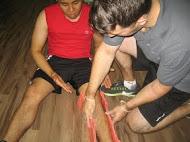Fact Checked
Symptoms Of A Broken Or Fractured Bone
- The casualty may feel or hear a crack in the bone;
- The area is tender and painful to touch;
- Inflammation around the assumed fracture;
- The limb is in an abnormal position;
- Excruciating movement;
Keep the casualty warm and immobile, treat for medical shock if required. DO NOT move the casualty until a splint has been used, except there is risk of a severe emergency. - Irregular motion of the affected limb;
- There will be loss of function of the affected limb;
- There will be a grating or chafing feeling; and
- There will be bruising surround the affected area.
Treatment Of Broken Or Fractured Bone
- Keep the casualty warm and immobile, treat for medical shock if required. DO NOT move the casualty until a splint has been used, except if there is risk of a severe emergency.
- If the bone is assumed to be broken but does not penetrate the skin (known as a closed fracture), splint the affected body part before the casualty is moved, restraining the joint above and beneath the fractured area.
- If a broken bone penetrates the skin (open fracture), apply force to the correct pressure point to stop the bleeding. DO NOT attempt to straighten out the affected limb or return it to its usual position. DO NOT touch or wash the affected wound. Place an antiseptic pad or fresh cloth firmly in place above the wound and connect with strong bandages.
- If the casualty must be relocated, place a splint to avoid further injury. Use whatever you can to prevent the broken bones from moving, such as boards or broomsticks. Pad the splints with pieces of cotton, clothing or clean rags knotted firmly (but not tightly) in place. If the casualty complains of lack of feeling, undo the splint.
- Get expert medical assistance immediately
